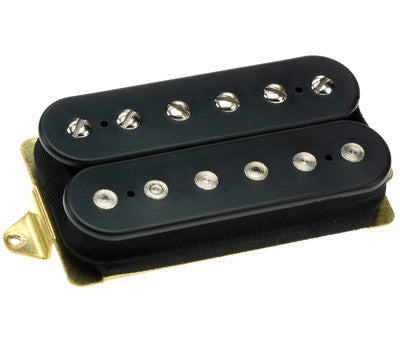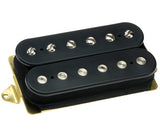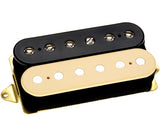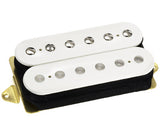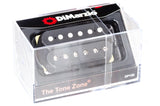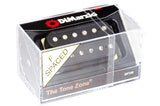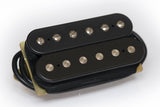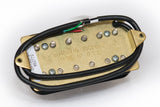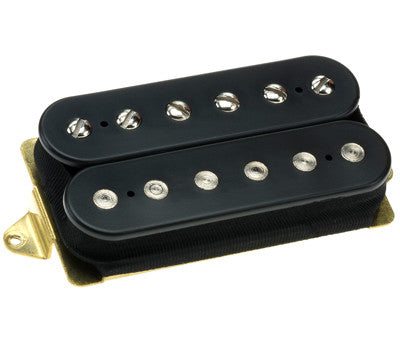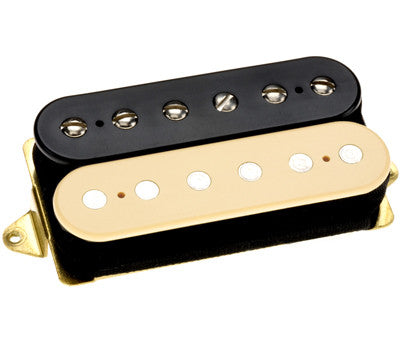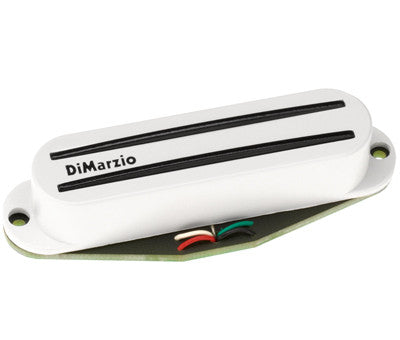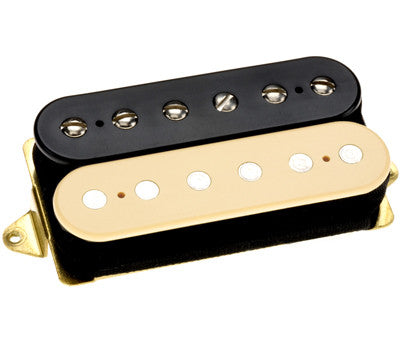From the manufacturer:
Have you ever heard a bridge pickup that made a guitar sound like a giant mosquito attack? If you’ve run into this problem, The Tone Zone® is the solution. The Tone Zone® is hot enough to qualify as a high-output pickup, but it has a wider dynamic range — hard picking will produce a lot of power, and softer picking will be much cleaner and quieter. It’s got tremendous bass and low-mid response to reinforce the bottom end and make the overall sound bigger. The highest single notes have depth, and chords sound huge. Patented dual-resonance coils reproduce more overtones than you’d expect from such a fat-sounding pickup. It makes a great match with an Air Norton™, PAF Joe™, or PAF Pro®, and split-coil mode produces an excellent single-coil sound as well.
The Tone Zone® is hot enough to qualify as a high-output pickup, but it has a wider dynamic range — hard picking will produce a lot of power, and softer picking will be much cleaner and quieter. Many models can be used in the neck position, from the Air Classic™ to the Air Zone™; the PAF Pro® and the FRED® are also good choices. Higher-output single-coil replacements like The Cruiser® and Fast Track 1™ are also recommended.
Seth's picks for best videos/sound clips:
This video features the DiMarzio DP155 The Tone Zone in kind of a unique arrangement: it is paired with a Fender Texas Special Tele Neck Pickup in an SX SST/ASH Guitar With a single 250k volume control, a 3-way toggle switch, and a mini toggle for coil-tapping the DP155. He is using the Line6 PODxt Live through a VOX AC30 amplifier. He starts by playing some with the neck pickup, then at 0:49, he switches to both pickups with the Tone Zone coil-tapped, and it sounds very much like a Tele in the middle position. He switches to the Tone Zone alone at 1:28, and it is still coil-tapped and sounding very "Stratty." At 1:57 he decides to show us that much like the Dread Pirate Roberts fighting left-handed, he has been keeping up from the fact that he isn't playing with his volume up all the way, so he turns it up to the maximum and lets loose with some Classic Rock-style riffs, letting us hear the amp break up a bit more with the extra volume. He dispenses with the coil-tap at 2:08, allowing the full power of the DP155 to shine through. This pickup to me has a very pronounced midrange hump, and makes this guitar sound very "Les Paul-ish" to my ears. He re-engages the coil-tap at 2:46, playing some wicked country-style hybrid picking. From 2:56 to the end, he switches back and forth between the full humbucker sound of the DP155, to the coil-tapped sound, bouncing between them every few seconds to the end. Cool stuff. Way more than I would expect from a Strat style guitar.
Here's a quick one featuring the DP155 The Tone Zone in the bridge position of an Ibanez S1540...I think. He's also playing through a Line 6 POD X3 with a lot of distortion and delay on the guitar. He starts by playing some hard rock riffs and fills and such, before switching to a "different" gain profile on the Pod at 1:00. The Tone Zone really cuts through, especially on these types of guitars with gain settings like these. He plays some more classic rock riffs and fills and turns the gain up and seems to add more chorus at 1:46. Here he unleashes his two hand tapping skills, then plays some more riffs and tapping licks until the end. Very much the Paul Gilbert sound!
So this one is evidence that you can totally sound like Eddie Van Halen with the DP155. This one is technically a DP155F, the "F" at the end indicates that this pickup in wide-spaced, or "Fender-spaced" hence the "F." This pickup is in what appears to be a late 70's Fender Stratocaster and he's playing through the Line6 PODxt and the MXR Phase 90. Just pick a spot and listen. Very good copping of the Eddie sound and feel. I especially like the way this pickup treats harmonics, both natural and pinch, and what REALLY impresses me is that somehow he stays in tune after using this whammy bar!
This guy's video is a good illustration of the DP155 used for some shreddy-type music...but the whole demo is just about a minute and forty-five seconds at the end of the video. He's a talker! Interestingly, he's pairing it with the PAF DP103, but not in the way you'd think. He's got the Tone Zone in the neck position, even though it's a higher output pickup. You'll want to skip to 3:20, so you miss the talky parts. He just starts in at 3:20, playing what I think is an Ibanez RG1550 through his Behringer V-Amp Pro. He does some face-melting sweeps, then he plays some Steve Vai, then you can see that he's been studying his Paul Gilbert Intense Rock videos, because he plays two licks from those vids starting at 3:39. Nice cleanly picked shreddy goodness. Again, lots of midrange. Cool pickup.
Here's another Paul Gilbert fan, this time playing an Ibanez RG2ex1 with the DP155 in the bridge through a Crate Power Block plugged into a Carvin 412 cabinet. He starts with a demo of the clean sounds possible, playing some Racer X and Metallica. He changes to a distorted sound 0:35, letting us hear the sound of the guitar alone. Mids. I know. I say it a lot, but it's true, the Tone Zone has the Mids. He ends the video by playing a Paul Gilbert song with a backing track. Nice sound. I was not expecting this pickup to sound so good through this amp. Good stuff.
This one is a comparison between the stock bridge pickup in a 2010 Ernie Ball Sillhouette and the Tone Zone. He starts by explaining that he's using a Line6 POD HD400 for his tone. He starts playing at 1:07 with some clean chords on the stock Ernie Ball pickup, switching to a distorted sound at 1:25. He plays with the distortion for a good minute or so, playing all kinds of rock riffs. Then the video cuts, and we resume with the Tone Zone installed in the guitar. The clean playing starts at 3:07, and the DP155 seems chimey and thicker than the stock one to me. At 3:30, we hear the Tone Zone with the distortion kicked on, playing the same classic 80's metal riffs. Here the Tone Zone sounds REALLY thick, nice low mids. Power. Beauty. The dryer gets some great tone too.
Here's a comparison of the sounds of the stock Ibanez pickups in an RG1XXV Premium (built by DiMarzio), the DiMarzio Evo Pickups in an Ibanez Jem 70V Premium Ibanez RG550 LTD, and an Ibanez RG550 LTD with the Tone Zone in the bridge and the DiMarzio Air Norton in the neck. He starts off clean, playing the same thing on all three guitars, getting to the Tone Zone at 0:31. It's a fairly stark contrast. The DP155 sound much darker, much more mid heavy than the other examples. At 0:47, he dials in the distortion, and plays the same vaguely-Metallica-ish riff followed by some pentatonic leads on all three guitars with the bridge pickup. He gets to the Tone Zone at 1:15, and the one word that comes to mind as I listen to this pickup in comparison to the other two is: THICK. The remainder of the video is a comparison of the neck pickups in each guitar, none of which concern us at the moment, as none of these have a Tone Zone in the neck. Remember: Tone Zone = MID THICKNESS.
This is another one in the "Comparing the Tone Zone to the Stock Ibanez Pickups" genre. This is xAirForceMikex and his Ibanez RG470AH Playing through IK Multimedia's Guitar Rig 5 modeling software. He starts by playing the stock Ibanez bridge pickup, the INF2, clean at 0:13. He switches to a distorted setting at 0:55, and plays some power chords and lead lines. Next we hear the Tone Zone played through the same sets of examples, first clean, at 1:28, then with the juice turned up at 2:09. This video is interesting to me because in the other demo videos I've noted the huge thick mids this pickup has, whereas in this one, the DP155 seems very present, with nicely defined high frequencies. Perfect for cutting through in a live situation. Thick and chimey!
Here's another from Rafport, and it's a comparison of all the bridge pickups in a bunch of his guitars. He's playing them all through his Line 6 PODxt Live, and while it's obviously not a true "apples to apples" comparison of these pickups, it does yield some cool things. He starts the video off by playing all his guitars with the same clean sound through the POD. He plays each example the same way on four different guitars, each with a different kind of bridge pickup. First is the BaCH LP-Style guitar with a Wilkinson PAF then a Yamaha Pacifica 812V with a Seymour Duncan JB, then an SX SST Ash with the Tone Zone, then a BaCH BST with a DiMarzio Evolution. The first example he plays on all these guitars is a clean chordal passage, and here the Tone Zone sounds powerful and large. Lots of harmonic content. At 0:55, he starts another comparison, this time using a "medium gain" rhythm sound. When the Tone Zone Rolls around at 1:08, it has massive amounts of low end to my ears, when juxtaposed with the other pickups here. For his next illustration, starting at 1:23, he keeps the same medium gain sound as before, but plays some lead this time. I hear mostly an emphasis in the low-mid frequencies when he plays the Tone Zone at 1:41. Hi Gain riffs are the next thing he plays on all guitars. Again, here I'm struck by the DP155's treatment of lows and low mids. Less piercing highs than some of the others have. Keeping the same high gain setting, he plays a quick blues scale lick on each guitar, starting at 2:37. I like the Tone Zone here, the highs seem rolled off just a hair, but still sounding huge and direct. At 3:10 he gives us a taste of how the pickups sound when coil-tapped (with the exception of the Wilkinson, which is a two-lead pickup, not designed for coil tapping). Again, when we hear the Tone Zone tapped at 3:21, it sounds like a single coil with a pronounced bump in the low-mids, just as you'd expect. Cool piece of work here, and although these pickups are in totally different guitars, I think we can hear enough of each of the pickups' essential character. Nice stuff.
This one is just a pure expression of the power of the DP155. This guy seems to be playing a guitar sort of based on Edward Van Halen's first black and white Frankie. He is just using the guitar through an interface and into his IK Multimedia Guitar Rig 4 software. He plays for the most part on the Tone Zone, but there are times when he's just in The Flow and he switches to the neck position single coil, what ever that is. Check out the following places of guitar playing and guitar tone prowess: 1:24, 1:55, 2:14, 2:22, 3:14, and 4:21. The Tone Zones have that power and clarity. They work very well in these high gain situations.
This is another one with a guy just shredding on the Tone Zone in his guitar for the whole video, but this one is a different genre than the other one, so it's an interesting listen. This guy is playing his Parker GM20 with the DP155 in the Bridge position, and he never deviates from that setup. His first entrance is pretty great, a cool ascending legato lick in what seems like E Phrygian at 0:19. He continues the legato goodness at 0:39. The Tome Zone sounds clear and woody here, with nice mids, giving it some strength. This guy plays great, watch for the two handed stuff at 2:36 and the sweeps from about 3:33 to the end. Again, nice tone and power coming from this Tone Zone.
Here's another comparison video using different guitars with different pickups playing the same example so we can hear how the DP155 stacks up against several other brands and types of pickups. He's an Ibanez fan, so he plays 5 different versions of essentially the same guitar--an Ibanez RG Custom with two humbuckers through his Fractal Audio Axe-FX II guitar processor. The RG he starts with is made of mahogany with a maple top and a bolt-on neck and has a DiMarzio D-Sonic in the bridge position. At 1:02, he switches to a different bolt-on necked RG made of mahogany with a maple top having an EMG 85 in the bridge, before switching to a solid alder RG with a bolt-on neck that has a DiMarzio Crunch Lab in the bridge position, at 1:59. At 2:54, he switches to yet another RG, this time made of solid ash, featuring the Tone Zone in the bridge. It's interesting. I hear the pronounced mid bump here in the high mid frequencies, especially when contrasted so closely with the Crunch Lab, which I feel has a mid bump in a slightly lower notch in the frequency spectrum. That being said, I think this pickup cuts through a lot better than the Crunch Lab, at least in this setting. Finally, at 3:49, just when you think he has rum out of Ibanez RG's to play, he produces one more, again with a mahogany and maple body (I think I'm beginning to see this guy's preference), but this time with the EMG 81 in the bridge. This one sounds the closest in character to me to the Tone Zone, but again, the frequencies bumped in the mids are slightly lower, causing it to get a little lost in the mix, not as present and out front as the Tone Zone seemed to be.

